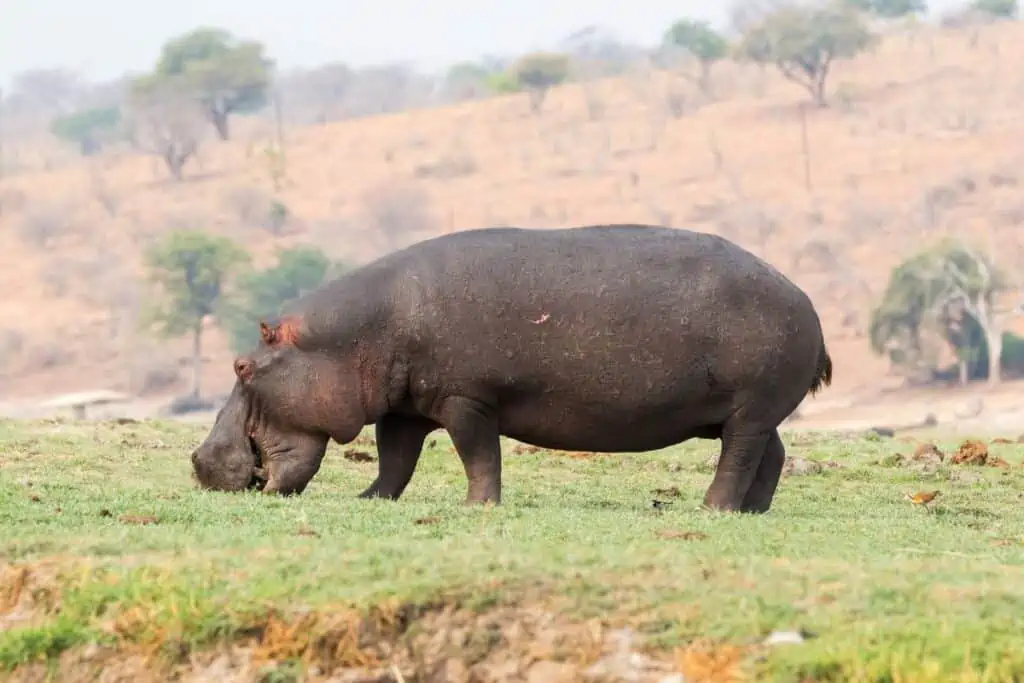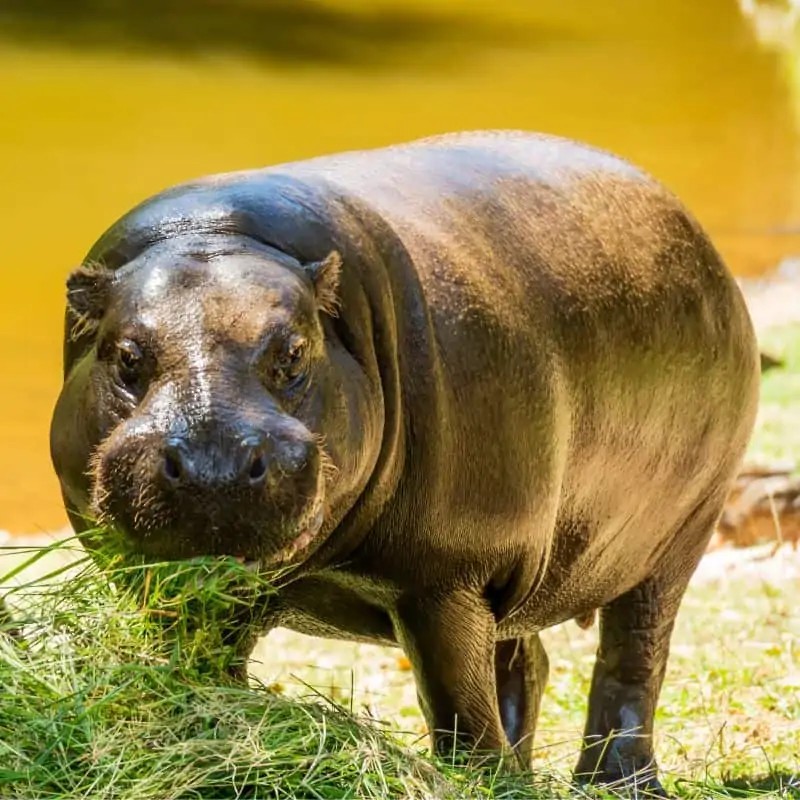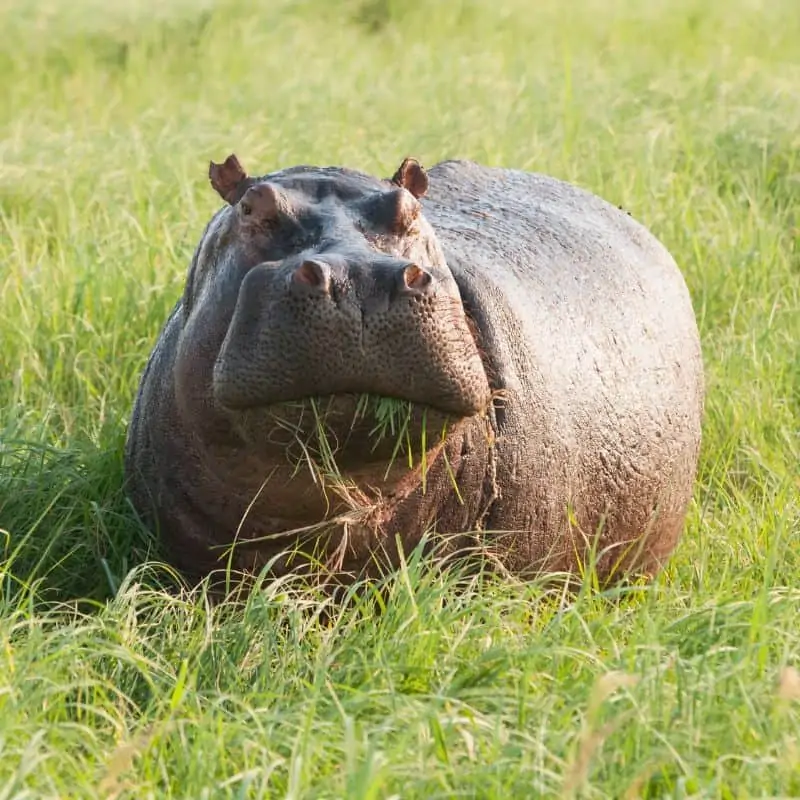Hippos are the third largest land mammals, and with that massive size and weight comes a monumental diet to match. So, what do hippos eat to maintain their massive size?
Hippos are herbivores and eat mostly short grass. They also eat shoots, reeds, leaves, and roots. In captivity, many also eat fruit and vegetables as well.
In this article, we’ll expand further on the hippopotamus diet and their eating habits.

Hippo Diet
Only two types of hippos exist today: common hippos and their smaller cousin, pygmy hippos. Although they’re both hippos, their diets do differ.
The main similarity between these two hippos is that they’re both herbivores.
Common Hippos
Common hippos are the more recognized type of hippos. They’re native to Eastern Africa and can grow to a height of a little over 5 feet at the shoulder. Their bodies are also large, reaching 10.8 to 16.5 feet.
Although common hippos are semi-aquatic, they only feed on land. Out of all land food sources, they mostly graze on short grasses. Baby hippos have been known to nurse underwater, though.
Grass
Typically, common hippos eat grasses, including green shoots and reeds. That’s because smaller grasses are the easiest to grasp with their mouths.
Common hippos’ diet tends to create habitation for other animals. It’s especially evident in the Okavango Delta in Botswana.
When hippos graze on grass, they build flood drains from their trails. These paths collect water during the rainy season to serve as water holes for the dry season. They even serve as water paths for smaller fish.
Some of the common hippos’ favorite grasses are:
- Cynodon
- Panicum
- Heteropogon
- Sporobolus
- Tragus
- Brachiaria
- Urochloa
- Chloris
- Setaria
- Cyperus
Pygmy Hippos
Unlike the common hippos, pygmy hippos have rounder heads and longer feet. They also have less-evident webbed feet since they spend less time in the water.
Pygmy hippos can only grow to around 3 feet and are 4.5 to 6 feet long. Compared to common hippos, pygmy hippos are only one-sixth their size.
You can see most of the pygmy hippos in Liberia, with a portion of them living in the Ivory Coast, Sierra Leone, and Guinea.
They also eat grass but mostly eat leaves, roots, and fruits as their primary food source.

Leaves
Pygmy hippos benefit more from eating leaves than grasses. In the wild, they’ll also feast on fallen leaves. However, they get more variety when they’re in captivity.
For example, zoo keepers may give them different kinds of leaves for nutrition. These leaves may include lettuce, alfalfa, and ferns.
Roots
Instead of grass, pygmy hippos prefer roots. They get more nutrients from roots than from grass. As a result, their consumption of roots is greater than those of common hippos.
Pygmy hippos will travel into the forest to scavenge for roots. They’ll usually follow game trails to find food easily.
Fruits and Vegetables
Pygmy hippos don’t necessarily consume fruits in the wild. That’s because there aren’t many fruits in their natural habitats.
However, since pygmy hippos are endangered, many live in captivity to protect their species. As a result, they may also get fruits and vegetables as part of their general diet.
For pygmy hippos, fruits such as watermelons are excellent treats. Sometimes, zoo keepers may also provide them with nutritious pumpkins.
Do Hippos Eat Meat?
As herbivores, both the common hippos and pygmy hippos don’t eat meat. Not only don’t they have the proper dental structure for grinding meat, but their digestive system also can’t break down meat very well.
However, desperate times can call for desperate measures. So, hippos sometimes turn to meat or cannibalism to satisfy hunger during drought.
Reports have proved that hippos scavenge for meat when there isn’t enough grass and vegetation to eat.
With their large bodies and strong bite forces, hippos can easily attack a large animal. So, it’s no surprise they’d consume meat due to nutritional deficiency.
They may consume other wild animals, such as elephants, impalas, zebras, wildebeest, and other hippos.
How Much Do Hippos Eat?

Hippos eat at least 1-1.5% of their body weight daily. They only eat that much because of their mostly sedentary lifestyle. As a result, they also have a sluggish metabolism.
An adult hippo consumes 55 to around 88 pounds of food per day. However, they can also eat up to 150 pounds of grass occasionally.
The unique thing about hippos’ digestive system is they can store grass in their stomachs.
So, they can go without food for up to 3 weeks. However, they only practice this habit if there isn’t enough food.
When Do Hippos Eat?
Hippos’ eating schedule is mostly at night. They cool their bodies down under the water during the daytime.
This eating habit makes both types of hippos nocturnal. As a result, they don’t consume heavy food since they can conserve their energy during the day.
Typically, hippos will start looking for food once the sun goes down. At this point, the temperature won’t be as hot as it was during the day. So they can freely move around without getting dehydrated or suffering from extreme heat.
Many hippos can walk more than 6 miles from their watery nests before returning. They can stay on land for 4-6 hours during feeding.
You’ll know where hippos go for their food because of the walking patterns they create. Their heavy feet and large bodies easily create gulfs that change the water flow patterns from rivers and lakes.
Instead of new grass growing on the soil, hippos create a “hippo lawn.” This lawn is where most hippos gather to satisfy their hunger.
Final thoughts on the hippo diet
Regardless of whether it’s the common hippo or the pygmy hippo, both types rely on grass and vegetation. That’s because hippos are herbivorous animals.
Common hippos eat much more grass than pygmy hippos, while pygmy hippos also go into the forest to search for roots and other vegetation.
We hope this article has shed some light on these massive creatures eating habits.
